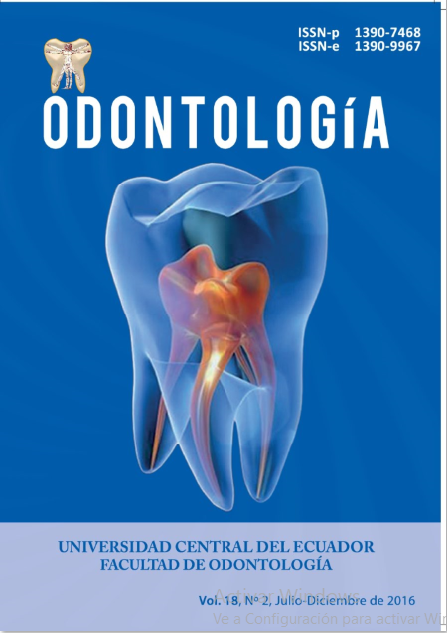Reducción bacteriana del agua ozonizada sobre actinomyces israelli
Palabras clave:
Agua ozonizad, hipoclorito de sodio, Actinomyces israelii, periodontitis apicalResumen
El Actinomyces israelii es considerado un microorganismo patógeno de los tejidos periapicales del diente, es difícil de erra-dicar por los pocos nutrientes y oxígeno que necesita para subsistir originando así una periodontitis apical. Objetivo: Com-parar el efecto bactericida sobre Actinomyces israelii del agua ozonizada al 5%, hipoclorito de sodio al 5.25% y clorhexidina al 2% Materiales y métodos: Fueron inoculados con Actinomyces israelii en 40 conductos uniradiculares humanos, se midió la reducción bacteriana luego de su aplicación a través de conteo de UFC/placa, posterior a la irrigación y recambio constante de las presentes soluciones, fueron divididos los 40 dientes en 4 grupos: G1: Suero fisiológico, G2: Agua ozoni-zada 5%, G3: Clorhexidina 2% G4: Hipoclorito de sodio 5,25%, la significancia estadística fue a través del Test de Tukey con un nivel de significancia de 5%. Resultados: Se evidenció con el Test de Tukey valores de media para Hipoclorito de sodio 5.25% de 0, para clorhexidina 2% de 0 y para Agua ozonizada una media de 0.3 por tanto esta prueba determinó que NaOCl al 5.25% es el tratamiento de primera elección seguido por clorhexidina 2% y se ubicó en tercer lugar la capacidad antibacteriana de agua ozonizada 5%. No se encontró diferencias significativas sobre la acción del agua ozonizada y las otras soluciones (< 0.15). Conclusiones: El agua ozonizada al 5% se mostró efectiva en la reducción bacteriana de A. is-raelli así como el NaOCl al 5.25%, sin presentar diferencias estadísticas significativas.
Descargas
Citas
Siqueira JF, Rocas IN. Microbiología endodóncica. In Torabinejad M. Endodoncia, Principios y Práctica. Es-paña: Elseiver; 2010. p. 38 - 4
Sundqvist G, Figdor D. Life as an endodontic patho-gen. Ecological differences between the untreated and root-filled root canals. Endodontic Topics. 2003; 6(1).3-28.
Piovano S. Microbiología de las enfermedades gingi-voperiodontales, de la periimplantitis, de los conductos radiculares y de los procesos perirradiculares. In Ne-groni N. Microbiología Estomatológica: Fundamentos y Guía Práctica. Buenos Aires: Médica Panamericana; 2009. p. 319-324.
Jhajharia K, Parolia A, Vikram SK. Biofilm in endo-dontics: A review. Journal of International Society of Preventive & Community Dentistry. 2015; 5(1). 1-12.
Radcliffe CE, Potouridou L, Qureshi R, Habahbeh N, Qualtrough A, Worthington H, et al. Antimicrobial acti-vity of varying concentrations of sodium hypoclorite on the endodontic microorganisms Actinomyces israelii, A. naeslundi, Candida albicans and Enterococcus faecalis. International Endodontic Journal. 2004; 37(7). 438-46.
Tessier J. El ozono en odontología. Dental Tribune. 2014; 2(1). 21-2.
Monzavi AE. In vitro and ex vivo antimicrobial effica-cy of nano-MgO in the elimination of endodontic pa-thogens. Clin Oral Investing. 2014; 19(2). 56.
Recai Z, Gizem K, Ihsan H, Zeynep S, Tutku T, Zuhal M. Bactericidal effects of various irrigation solutions against Staphylococcus Aureus in human root canal. Journal Istanbul Univ. Fac. Dent. 2015; 49(1). 19-24.
Ochoa JD, Rendon JA, Morales S, Ferrer ME. Redi-CES. [Online].; 2016 [cited 2016 abril 13. Available from: http://hdl.handle.net/10946/4091.
Cardoso M, Dias L, Yumi C, Cardoso AO. Effective-ness of ozonated water on Candida albicans, Entero-coccus faecalis, and endotoxins in root canals. Oral Surgery, Oral Medicine, Oral Pathology, Oral Radiolo-gy. 2008; 105(3). 85-91.
Huth KC, Quirling M, Maier S, Kamereck K, Alkhayer M, Paschos E. Effectiveness of ozone against endodon-topathogenic microorganisms in a root canal biofilm model. International Endodontic Journal. 2009; 42(1). 13.


